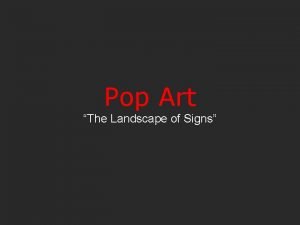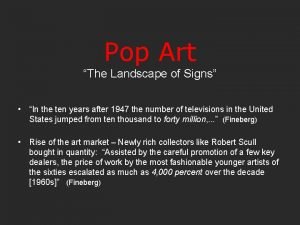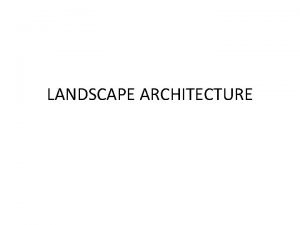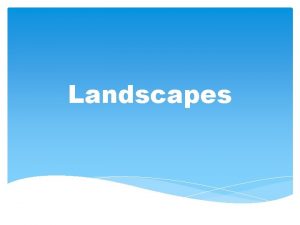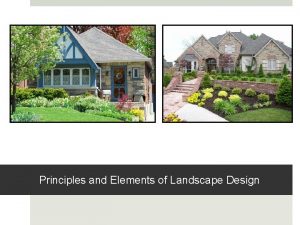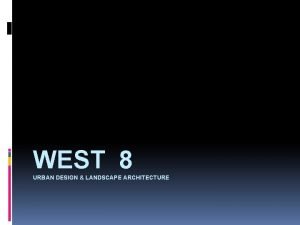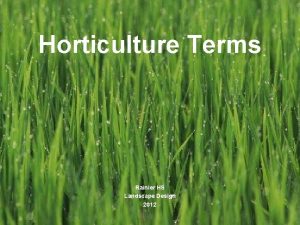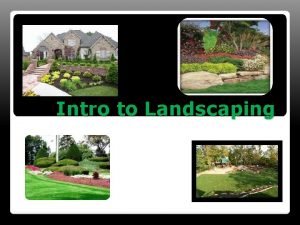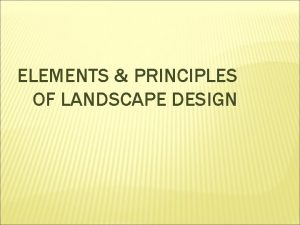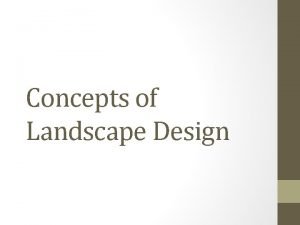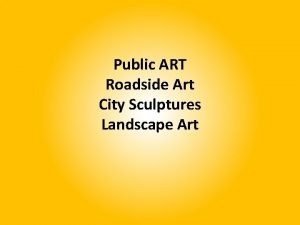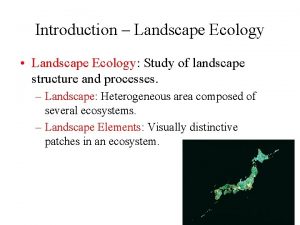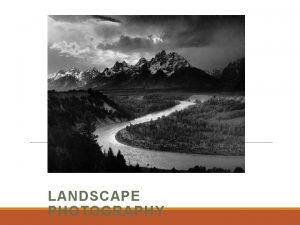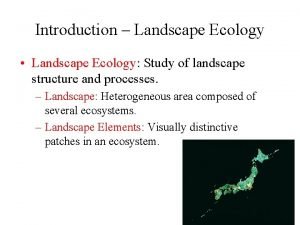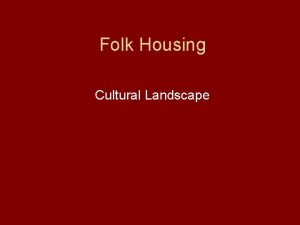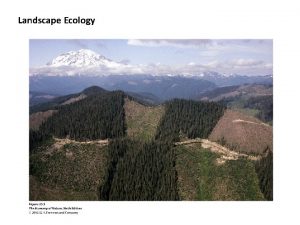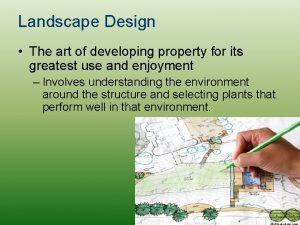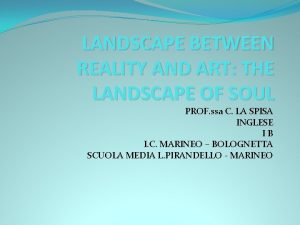Landscape Design Landscape Design The art of developing




































- Slides: 36

Landscape Design

Landscape Design • The art of developing property for its greatest use and enjoyment – Involves understanding the environment around the structure and selecting plants that perform well in that environment.

Landscape Value Determinants Good design results in adding value to property and enhancing quality of life. • • ©i. Stockphoto. com Aesthetic appeal Economic value Functional value Environmental effects

Aesthetic Appeal • Add visual beauty • Hide undesirable features • Emphasize desirable features • Appeal to all five senses – – – Sight Hearing Touch Taste Smell ©i. Stockphoto. com

Economic Value • Increase property value 6 to 15 percent • Reduce energy costs – Buffer wind – Control solar heat gain Courtesy USDA ©i. Stockphoto. com

Functional Value • • Aesthetic value Enhance livability Conservation and environmental protection Solar heat control Wind control Sound control Slope stabilization ©i. Stockphoto. com

Environmental Effects ©i. Stockphoto. com Landscaping can • Moderate temperatures • Reduce glare and wind • Use water more efficiently • Clean the air • Provide wildlife habitat Bird and Butterfly habitat

Rules and Regulations State, local, and/or community regulations may control landscape design. • Storm water drainage • Tree ordinances • Street trees • Street yard • Buffer yards • Street wall • Parking screen and islands • Trash screen

Rules and Regulations Storm water regulations ©i. Stockphoto. com

Rules and Regulations Tree Ordinances ©i. Stockphoto. com

Rules and Regulations Street Trees

Rules and Regulations Street Yard

Rules and Regulations Buffer Yards

Rules and Regulations Parking Screens and Islands

Rules and Regulations Trash Screen

Unintended Results of Landscaping • Air Pollution: Gasoline-powered landscape equipment (mowers, trimmers, blowers, and chainsaws) account for more than 5% of our urban air pollution. • Chemical Toxins: Residential application of pesticides is typically at a rate 20 times that of farmers per acre. • Solid Wastes: Yard wastes (mostly grass clippings) comprise 20% of municipal solid waste collected. Most still end up in landfills. • Flooding and Water Pollution: A lawn has less than 10% of the water absorption capacity of natural woodland – a reason for suburban flooding.

Environmentally Friendly Landscaping • • • Protect natural areas Reduce turf Mulch planted areas Use native plant species Reduce energy consumption – Low maintenance landscaping – Environmentally friendly materials • Use Xeriscape techniques Courtesy EPA

Xeriscape Landscaping philosophy that seeks to minimize the need for water. 1. Proper planning and design 2. Soil analysis / improvements 3. Appropriate plant selection 4. Practical turf areas 5. Efficient irrigation 6. Use of mulches 7. Appropriate maintenance Xeriscape in Colorado

Water Use Zones PLANTING TYPE WATER USE Native Plant Low Cactus Garden Low Herb Garden Moderate to Low Fruit Trees Moderate Flower Garden High Vegetable Garden Moderate to High (depends on crops) Wildflower Meadow High (germination) Low (once established) Lawn Moderate to High Group plants by water use zones

Principles of Design Concepts used to organize the elements of a design • • Repetition Balance Emphasis Unity

Principles of Design Repetition • Use of the same element over and over • Repetition is achieved when the same line, shape, color, texture, plant, or material is used throughout the landscape

Repetition ©i. Stockphoto. com Which elements are repeated?

Principles of Design Balance • A sense of equality that can either be symmetric or asymmetric. Formal Balance – A symmetrical design in which the design can be divided into two identical halves. Informal Balance – An asymmetrical design that can not be divided into identical halves but that provides an overall sense of equilibrium.

Balance ©i. Stockphoto. com Formal Balance

Principles of Design Emphasis • The result of focusing attention on one aspect of a design. • Emphasis is constructed by creating a visual path from at least one vantage point to the focal point. Focal Point – The object of attention Vantage Point – The place from which the focal point is viewed

Emphasis What is the focal point? Image by the Environmental Protection Agency

Principles of Design Unity The impression that the separate parts of the design belong together or are part of a whole. Unity is created by • A consistent style (Japanese, formal, etc. ) • Visual pathways • Consistent color scheme • Repetition of lines, plants, and hardscape

Unity ©i. Stockphoto. com Is the design unified? Why?

Landscape Design Process Concept (Master) Plan § Delineate spaces – Hardscape – Planting beds – Turf areas Use straight lines or smooth curves § Locate plants by broad classification —Deciduous or coniferous —Tree or shrub —Groundcover —Turf

Concept Plan

Landscape Design Process Hardscape – Driveway, walks, patio, deck, walls, and fences – Garden structures – Gazebo, trellis, arch – Garden ornaments – fountains, sculptures birdbaths, etc. – Furniture ©i. Stockphoto. com

Landscape Design Process Plant Material – – Height Spread (width) Deciduous or coniferous Form or shape (columnar, cone, round) – Growth rate – Growing conditions • Sun, moisture, soil conditions – Hardiness zone ©i. Stockphoto. com

USDA Plant Hardiness Zone Map http: //www. usna. usda. gov/Hardzone/ushzmap. html

Landscape Design Process Planting Plan Indicates the location and species of plants ©i. Stockphoto. com

Planting Plan

Image Sources Environmental Protection Agency. (n. d. ). Ariel Rios building south courtyard perspective. Retrieved at http: //www. epa. gov/greeningepa/stormwater/ars_perspe ctive. htm. istockphoto. (n. d. ). Retrieved at http: //www. istockphoto. com/index. php. United States Department of Agriculture. (n. d. ). Conservation practices that save: Windbreaks/shelterbelts. Retrieved at http: //www. nrcs. usda. gov/technical/energy/windbreaks. ht ml.
 Developing minds by art costa
Developing minds by art costa Pop art landscape
Pop art landscape October 18 1977
October 18 1977 Landscape art definition
Landscape art definition What is landscape art
What is landscape art Objectives of landscape design
Objectives of landscape design West 8 landscape architecture
West 8 landscape architecture Rainier landscape design
Rainier landscape design Kinsey landscaping
Kinsey landscaping What are the 7 principles of landscape design
What are the 7 principles of landscape design Proscape landscape design
Proscape landscape design Elements and principles of landscape design
Elements and principles of landscape design Rhino landscape design
Rhino landscape design Hát kết hợp bộ gõ cơ thể
Hát kết hợp bộ gõ cơ thể Bổ thể
Bổ thể Tỉ lệ cơ thể trẻ em
Tỉ lệ cơ thể trẻ em Voi kéo gỗ như thế nào
Voi kéo gỗ như thế nào Thang điểm glasgow
Thang điểm glasgow Alleluia hat len nguoi oi
Alleluia hat len nguoi oi Môn thể thao bắt đầu bằng chữ f
Môn thể thao bắt đầu bằng chữ f Thế nào là hệ số cao nhất
Thế nào là hệ số cao nhất Các châu lục và đại dương trên thế giới
Các châu lục và đại dương trên thế giới Công thức tính thế năng
Công thức tính thế năng Trời xanh đây là của chúng ta thể thơ
Trời xanh đây là của chúng ta thể thơ Mật thư tọa độ 5x5
Mật thư tọa độ 5x5 Phép trừ bù
Phép trừ bù độ dài liên kết
độ dài liên kết Các châu lục và đại dương trên thế giới
Các châu lục và đại dương trên thế giới Thơ thất ngôn tứ tuyệt đường luật
Thơ thất ngôn tứ tuyệt đường luật Quá trình desamine hóa có thể tạo ra
Quá trình desamine hóa có thể tạo ra Một số thể thơ truyền thống
Một số thể thơ truyền thống Cái miệng nó xinh thế
Cái miệng nó xinh thế Vẽ hình chiếu vuông góc của vật thể sau
Vẽ hình chiếu vuông góc của vật thể sau Nguyên nhân của sự mỏi cơ sinh 8
Nguyên nhân của sự mỏi cơ sinh 8 đặc điểm cơ thể của người tối cổ
đặc điểm cơ thể của người tối cổ Ví dụ giọng cùng tên
Ví dụ giọng cùng tên

